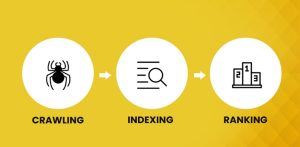Search engines rank websites using complex algorithms that consider various factors to determine the relevance and quality of web pages. While the specific algorithms are proprietary and continuously evolving, here’s a simplified overview of how search engines like Google generally rank websites:
- Crawling and Indexing:

– The process starts with search engine crawlers, also known as bots or spiders, which systematically browse the web, following links from one page to another. They discover and collect information from web pages.
– Once crawled, the data is indexed, which means it’s organized and stored in a massive database. Indexing helps search engines retrieve relevant information quickly when a user enters a query.
- Algorithmic Ranking:

– Search engines use complex algorithms to determine the order in which websites appear in search results. These algorithms take into account numerous factors to assess a website’s relevance and quality.
- On-Page Factors:

– Content Quality: Search engines evaluate the quality and relevance of the content on a page. High-quality, informative, and engaging content is favored.
– Keywords: Search engines analyze the presence and relevance of keywords on a page. Keywords should match the user’s search intent.
– Meta Tags: Elements like title tags, meta descriptions, and header tags provide context about the page’s content and are considered in rankings.
– User Experience: Factors like page load speed, mobile-friendliness, and secure HTTPS connections contribute to a positive user experience and are considered by search engines.
– Multimedia: The inclusion of images, videos, and other multimedia elements can enhance the user experience and improve rankings.
- Off-Page Factors:

– Backlinks: The number and quality of backlinks (links from other websites to yours) play a significant role. High-quality, authoritative sites linking to your content can boost your rankings.
– Social Signals: Engagement on social media platforms, such as likes, shares, and comments, can indirectly influence rankings.
- Technical SEO:

– Site Structure: The structure of a website, including its navigation, hierarchy, and URL structure, affects how search engines crawl and understand the content.
– XML Sitemaps: Providing XML sitemaps helps search engines understand the structure of your website and index pages more efficiently.
– Robots.txt: This file instructs search engine crawlers on which pages should or should not be indexed.
– Schema Markup: Structured data in the form of schema markup helps search engines understand the context of your content, which can enhance rich snippets in search results.
– Mobile Optimization: As mobile usage continues to rise, mobile-friendly websites are prioritized in rankings.
- User Signals:

– Click-Through Rate (CTR): A high CTR from search results indicates that users find your page relevant, which can positively impact rankings.
– Bounce Rate: A high bounce rate (users leaving your site quickly) can signal poor content or user experience and may negatively impact rankings.
- Content Freshness:

Fresh Content Influences Google Rankings
– Search engines prefer up-to-date content, especially for queries related to recent news, events, or trends. Regularly updating content can help maintain or improve rankings.
- Local SEO Factors:

– For businesses with physical locations, local SEO factors like Google My Business listings, online reviews, and local citations influence rankings in local search results.
- User Behaviour and Personalization:

– Search engines may personalize results based on a user’s search history, location, and previous interactions with websites.
- Penalties and Algorithm Updates:

– Search engines penalize websites engaging in black-hat SEO techniques (e.g., keyword stuffing, cloaking, or buying low-quality backlinks). Algorithm updates, like Google’s Panda and Penguin, aim to improve search results by targeting spammy or low-quality content and links.
- Competition:

– The level of competition for specific keywords or niches can affect rankings. In highly competitive fields, it can be more challenging to rank on the first page of search results.
- User Intent:

– Search engines strive to understand user intent. They aim to deliver results that match not just the keywords users type but also their underlying goals and needs.
In conclusion, search engine ranking is a multifaceted process that involves crawling, indexing, and algorithmic ranking. Search engines use a combination of on-page and off-page factors, technical SEO, user signals, and content freshness to determine the relevance and quality of web pages. It’s an ever-evolving field, with search engines continually refining their algorithms to provide users with the most relevant and useful search results. As a result, SEO requires ongoing optimization and adaptation to remain competitive in search rankings.
No related posts.






